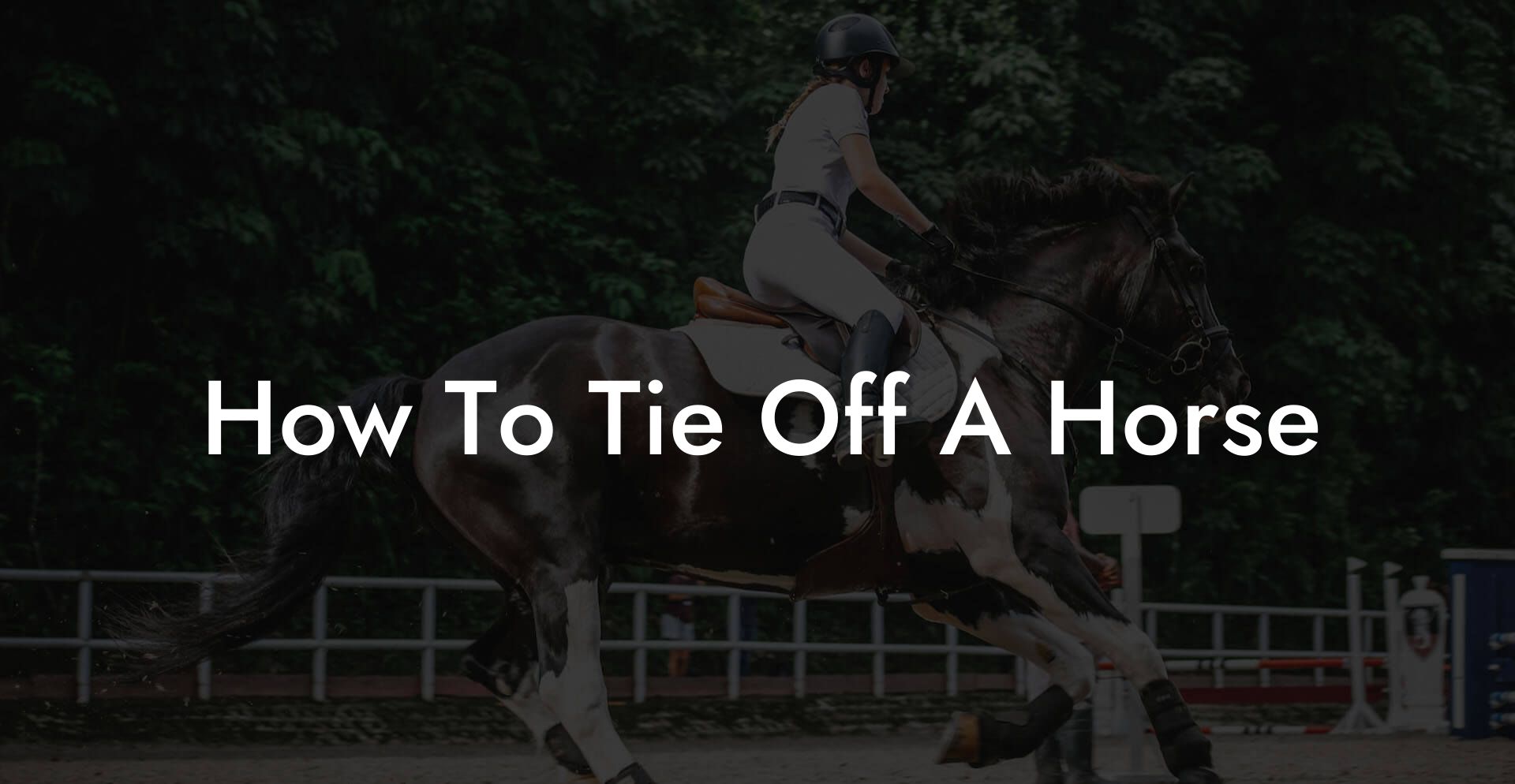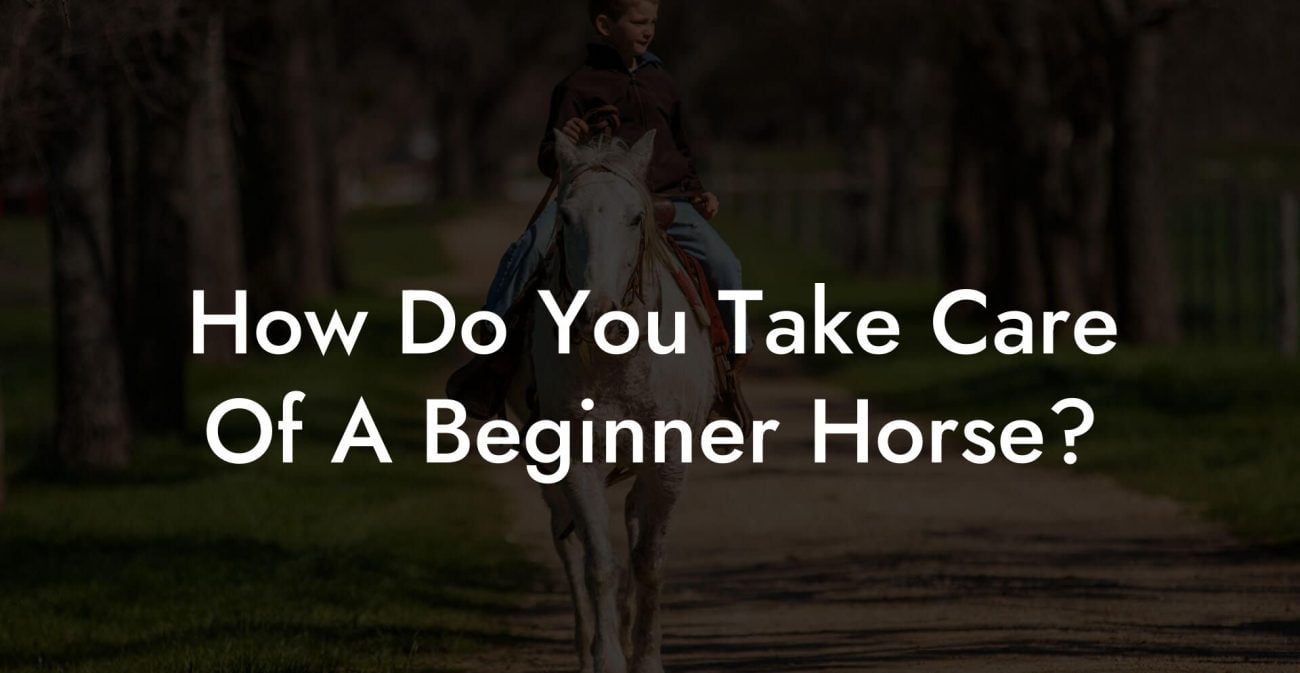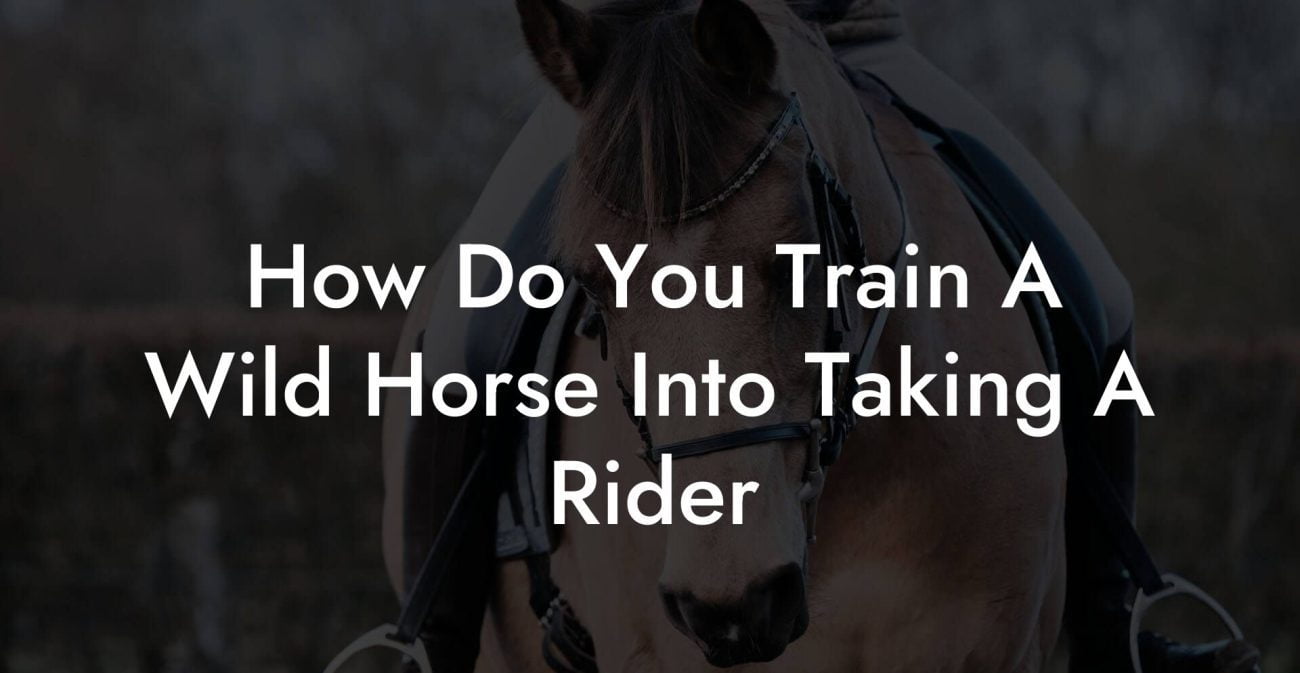Ever felt that rush of adrenaline when you finally master something new, like tying the perfect knot for your favorite pastime? If you're ready to level up your horse care skills and make sure your majestic steed is both safe and stylishly secured, you've come to the right place. This comprehensive guide on "How To Tie Off A Horse" dives deep into the art and science of tying off your horse with confidence, safety, and a good dose of humor. Whether you're a seasoned equestrian or a Gen-Z newbie just discovering the joys of horse care, we’re here to walk you through every step, from the right tools to common pitfalls, all wrapped up in an engaging, down-to-earth style.
Quick Links to Useful Sections
- Understanding the Importance of Properly Tying Off Your Horse
- Essential Tools and Materials for Tying Off Your Horse
- The Basic Gear You Need
- Optional Extras
- The Knot Know-How: Choosing the Right Knot for the Job
- Popular Knots for Tying Off Your Horse
- Step-by-Step Guide to Tying Off Your Horse
- Step 1: Prepare the Environment and Your Horse
- Step 2: Fit the Halter Correctly
- Step 3: Attach the Lead Rope
- Step 4: Approach the Anchor Point
- Step 5: Secure the Knot
- Step 6: Final Inspection
- Common Mistakes and How to Avoid Them
- 1. Using a Worn-Out Halter or Rope
- 2. Choose the Wrong Knot for the Situation
- 3. Skipping the Final Inspection
- 4. Ignoring Environmental Factors
- Safety Considerations and Understanding Horse Behavior
- Observing Your Horse’s Mood and Body Language
- Environmental Awareness
- Proper Communication and Commands
- Advanced Tips: grooming, Handling, and Tying Off Techniques
- Enhance the Experience with a Pre-Tie Grooming Routine
- Integrate Technology in Your Routine
- Regular Training Sessions
- Peer-to-Peer Learning and Community Feedback
- DIY vs. Professional Help: When to Seek Expert Advice
- Resources and Community Support: Your Next Steps
- Bringing It All Together: Your Journey to Confident Horse Management
- Frequently Asked Questions About Tying Off Your Horse
- Your Journey to Confident and Connected Horse Care
Understanding the Importance of Properly Tying Off Your Horse
Tying off your horse isn’t just about securing your four-legged friend; it’s about respecting your animal’s space, ensuring their safety, and protecting your valuable investment. Much like locking your smartphone with a strong passcode, using the right technique to tie off your horse prevents accidents and ensures that your equine buddy doesn’t wander off into mischief.
Beyond safety, properly tying off your horse reflects a deep understanding of animal behavior. You’re building trust by acknowledging that a tied horse should feel secure rather than stressed. When done correctly, tying off helps minimize anxiety for your horse while giving you peace of mind. Whether you’re leaving your horse in a stable for a short break or setting them free in a pasture, mastering this skill can truly change the game in your horsemanship journey.
In today’s fast-paced digital world, where even multitasking takes on a new meaning, being proficient at tying off your horse means you’re not only saving time but also prioritizing your horse’s comfort and well-being. So, let’s break down why this isn’t just another mundane task, but an essential part of modern horse care.
Essential Tools and Materials for Tying Off Your Horse
Before diving into the technique itself, it’s crucial to equip yourself with the right tools. Just like a well-curated playlist sets the scene for a perfect study session, having the proper equipment ensures that your tying off process is as smooth as your favorite remix.
The Basic Gear You Need
Equip yourself with these must-have items:
- Quality Halter: Your horse’s halter isn’t just a fashion statement; it’s the foundation of your tie-off process. Look for one that’s well-fitted, durable, and comfortable for your horse. Nylon and leather halters are both popular choices, depending on your horse’s size and temperament.
- Long Lead Rope: A sturdy lead rope gives you control, particularly when guiding your horse into their tie-off spot. Ensure it’s long enough to allow the horse some freedom but short enough to prevent entanglement.
- Secure Anchor Point: Whether it’s a tie rail, a hitching post, or a solid tree, your anchor point needs to be strong and immovable. Make sure it is at a comfortable height and in a location free from hazards.
- Quick-Release Mechanisms: For those unexpected moments when you need to free your horse in a hurry, quick-release buckles or clips can be a lifesaver, literally.
Investing in high-quality gear is non-negotiable. It ensures longevity, reliability, and, most importantly, the safety of your horse. Remember, a little upfront investment prevents a world of mishaps later on.
Optional Extras
For the tech-savvy equestrian looking to add extra flair and functionality, consider these add-ons:
- Reflective Accessories: If you’re tying off your horse near roadways or in low-light conditions, reflective gear improves visibility and safety.
- Smart Monitoring Devices: Yes, even horses can benefit from tech! Some modern setups include GPS trackers or activity monitors to keep tabs on your horse’s movement and overall well-being, ensuring they remain safe even when tied off.
With the right tools at hand, you’re already one step closer to becoming a pro at tying off your horse. And hey, nothing beats the satisfaction of knowing you’re ready to tackle this equestrian task head-on!
The Knot Know-How: Choosing the Right Knot for the Job
Now that you’re set up with all the essentials, it’s time to dive into the heart of the matter: the knots. Much like the perfect filter on your latest selfie, the right knot not only secures but also exhibits your attention to detail and expertise. Whether you’re looking to accomplish a secure tie or a quick release, selecting the right knot is key.
Popular Knots for Tying Off Your Horse
Here are some fan-favorite knots that equestrians have come to trust:
- The Bowline: Often dubbed the “king of knots,” the bowline creates a fixed loop that won’t slip. It’s celebrated for its reliability and ease of untying, even after bearing a load. Perfect for securing your horse to a stable post.
- Quick Release Knot: When you're on the go and may need to free your horse in an emergency, the quick release knot is your best friend. It allows you to untie the rope swiftly without compromising security.
- Clove Hitch: The clove hitch is ideal for securing your horse to a stationary object quickly. However, be cautious, if not adjusted properly, it may loosen over time. Pair it with a backup knot for added security.
- Slip Knot: While the slip knot offers convenience with its adjustability, it’s best used in low-risk scenarios as it can easily come undone if tension is not maintained.
Choosing the right knot depends on your specific circumstances, the environment, and your comfort level with the rope. Each knot has its quirks and benefits, get to know them, and you’ll be flexing your skills like a seasoned equestrian influencer.
Step-by-Step Guide to Tying Off Your Horse
Ready to roll up your sleeves and tie off like a pro? Follow our step-by-step guide that breaks down the process into manageable, easy-to-follow instructions. Grab your halter, lead rope, and let’s get started!
Step 1: Prepare the Environment and Your Horse
Before you even touch a rope, scout out a secure area. This means a flat, debris-free surface near a solid anchor point like a hitching post or tie rail. Calm your horse with gentle petting or a few kind words. A relaxed horse is a cooperative horse!
Step 2: Fit the Halter Correctly
Ensure your halter is fitted snugly but comfortably. A loose halter can lead to accidents, while one that’s too tight might stress your horse. Think of it as finding the perfect pair of jeans, comfort is paramount!
Step 3: Attach the Lead Rope
Secure the lead rope to your horse’s halter. Double-check that the knot or clip is secure. A frayed or unreliable attachment can compromise the whole setup.
Step 4: Approach the Anchor Point
Gently guide your horse toward the chosen anchor point. Use a calm, consistent tone to reassure them. This isn’t a race, slow and steady wins the safety game.
Step 5: Secure the Knot
Now it’s time to put your knot knowledge to work. Depending on your chosen knot, follow these sub-steps:
- For the Bowline:
- Create a small loop in the rope about 12 inches from the end.
- Pass the end of the rope through the loop from the underside.
- Wrap the rope around the standing part.
- Bring the end back down through the loop and tighten.
- For the Quick Release Knot:
- Form a loop with the rope, ensuring a loose end remains.
- Wrap the short end around twice to secure the loop.
- Ensure that the tail of the rope is long enough to pull and release the knot swiftly when necessary.
- For the Clove Hitch:
- Wrap the rope around the anchor point once.
- Cross the rope over itself to form an “X”.
- Complete the second wrap and tuck the end under the crossing point.
- Tighten the hitch securely, then double-check for stability.
Once you’ve secured the knot, give it a gentle tug to confirm that everything is holding firm. If there’s even a hint of looseness, redo it. After all, you wouldn’t want your horse to become an unplanned escape artist!
Step 6: Final Inspection
Walk around your setup and inspect your knot, halter, and entire rig. Ensure that the rope isn’t tangled and that your horse can stand comfortably without feeling restrained or uneasy. This final check is your secret weapon against mishaps.
With these steps, you’re equipped to tie off your horse safely and effectively. Remember, practice makes perfect, so don’t be discouraged if it takes a few tries to nail the technique.
Common Mistakes and How to Avoid Them
Even the most confident equestrians can fumble a knot or two. Identifying common mistakes and knowing how to avoid them is key to becoming a tie-off maestro.
1. Using a Worn-Out Halter or Rope
It might be tempting to reuse that trusted old rope, but frayed fibers and weakened halters can lead to dangerous slip-ups. Regularly inspect your equipment and replace anything that shows signs of wear.
2. Choose the Wrong Knot for the Situation
Not all knots are created equal. For instance, relying solely on a slip knot for longer periods might result in an unintentional release. Evaluate your situation and select a knot that provides the right balance of security and convenience. Experiment with various knots until you find what best suits your style and your horse’s temperament.
3. Skipping the Final Inspection
The final inspection is your safety net. Skipping this step can lead to overlooked mistakes, like a loosely tied bowline or an improperly set clove hitch, that could spell trouble when your horse decides to get frisky.
4. Ignoring Environmental Factors
Wind, moisture, and even the type of anchor point can affect your setup. Always consider the environment in which you’re tying off your horse. Wet conditions may make ropes slippery, while uneven ground might cause your horse discomfort. These factors, though small, play a huge role in overall safety.
Avoid these pitfalls by staying mindful of both your equipment and your environment. With each safe tie-off, you’re not only keeping your horse secure, you’re also honing your skills as a proactive, modern horse caretaker.
Safety Considerations and Understanding Horse Behavior
Safety is paramount when managing any animal, and horses are no exception. Their size, strength, and sometimes unpredictable nature mean that a secure tie-off is crucial. Before you even think about tying off your horse, take the time to understand their behavior.
Observing Your Horse’s Mood and Body Language
Horses are highly attuned to human emotions. Your tone, confidence, and energy level can all influence how relaxed your horse feels. If your steed appears tense, anxious, or unusually energetic, wait until they settle down before attempting to tie them off. A calm horse is easier to secure and less likely to resist, ensuring the safety of both of you.
Environmental Awareness
Consider your surroundings carefully. Tying off your horse in a busy area, near traffic, or in a location with a lot of distractions can increase stress levels. Choose a quiet, secure spot that’s free from hazards. This ensures your horse remains calm and reduces the risk of accidents.
Proper Communication and Commands
Clear verbal commands and gentle physical cues can help your horse understand what you’re trying to achieve. Consistent training and reinforcement over time not only build trust but also enhance your horse’s responsiveness when it’s time to move or settle down for a tie-off.
Understanding horse behavior is an ongoing process that each rider and caretaker should invest in. The more you know your horse, the better you can tailor your tying techniques to suit their unique personality and quirks.
Advanced Tips: grooming, Handling, and Tying Off Techniques
As you gain confidence in tying off your horse, consider integrating advanced tips that elevate your overall horse management game. Modern equestrians know that grooming, routine care, and proper tie-off techniques go hand-in-hand.
Enhance the Experience with a Pre-Tie Grooming Routine
Before you even bring out the halter and rope, take a moment to groom your horse. Brush away dirt and tangles, as well as any debris that could compromise the security of your equipment. A neat, well-groomed horse not only looks amazing, but also feels more relaxed and ready for the next step.
Integrate Technology in Your Routine
Embrace the future with smart tools that add a layer of safety to your process. Mobile apps and wearable trackers can help you monitor your horse’s behavior, while LED accessories can boost visibility during early morning or evening tie-offs. These modern touches underscore your commitment to both safety and style.
Regular Training Sessions
Consistent training builds muscle memory, for both you and your horse. Incorporate tie-off exercises into your regular routine, ensuring that both of you grow more confident and comfortable with the process. A few minutes a day of practice can dramatically reduce the risk of error when it counts.
Peer-to-Peer Learning and Community Feedback
Learning never stops, and the equestrian community is full of passionate, knowledgeable individuals eager to share their expertise. Join local riding clubs, online forums, or social media groups where you can swap tips, tricks, and even share videos of your tie-off achievements. The blend of traditional wisdom with modern techniques can offer fresh perspectives that help you elevate your skills.
Advanced techniques and ongoing learning are what separate the average from the accomplished. Every time you experiment with a new method or receive constructive feedback, you're one step closer to mastering the art of tying off your horse.
DIY vs. Professional Help: When to Seek Expert Advice
While self-training is empowering, there are times when expert guidance is worth every penny. If you're new to the world of equine care, a session with an experienced trainer or joining a horse care workshop can provide invaluable insights. Not only will you get hands-on instruction, but you’ll also have the opportunity to ask questions specific to your horse’s needs and your environment.
Professional assistance can help iron out any early mistakes, ensuring that your tie-off techniques are both safe and efficient. Plus, there’s something incredibly satisfying about learning from someone who’s been in the saddle for years, sharing stories over coffee (or a protein shake) can turn a routine lesson into an inspiring conversation.
Remember, success in horse care is as much about continuous learning as it is about practical experience. Even seasoned riders benefit from periodic refresher courses to stay updated with new advancements and safety protocols in the field.
Resources and Community Support: Your Next Steps
The journey to mastering how to tie off a horse is as much about community as it is about technique. Dive into a network of riders, trainers, and hobbyists who share your passion. The internet is your gateway to endless resources, including video tutorials, blog posts, podcasts, and online workshops, that can supplement your learning.
Here are some recommended resources for further exploration:
- Equestrian Forums: Sites like TheHorseForum.com offer lively discussions and troubleshooting over common challenges in horse care.
- YouTube Tutorials: Countless skilled equestrians post step-by-step video guides that visually break down the art of tying off a horse.
- Local Riding Clubs: Join groups or enroll in clinics where experienced riders demonstrate techniques, share personal experiences, and build lasting connections.
- Social Media Groups: Platforms like Instagram and TikTok have communities of modern equestrians who post daily tips and fun challenges related to horse care.
- Veterinary Advice: Sometimes, a quick check-in with your vet about behavior or equipment recommendations can reinforce good practices and highlight any areas for improvement.
Embracing community support not only boosts your skills but also transforms tie-offs from a solitary task into a shared experience among fellow horse enthusiasts. Your next step is all about connecting, learning, and growing together.
Bringing It All Together: Your Journey to Confident Horse Management
Mastering the art of tying off a horse is an empowering skill. It’s about safety, trust, and the unique bond between you and your equine companion. Each knot you tie, every piece of equipment you check, and each moment spent calming your horse contributes to a cycle of confidence and mutual respect.
As you integrate these techniques into your routine, you’ll notice that managing your horse becomes more than a chore, it transforms into a ritual that deepens your connection and reinforces your skills. From choosing the right gear to practicing your bonds and exploring advanced tips, every facet of this process is designed to make you a well-rounded, modern horse caretaker.
The journey to confident horse management is ongoing. Continue to explore, experiment, and engage with the vibrant community of equestrians around you. Whether you’re sharing a quick tip on social media or attending a weekend clinic, each interaction and practice session builds towards mastery.
So, grab your halter, straighten your lead rope, and take that next step in your horsemanship journey. With every knot you tie, you're not only securing your beloved horse but also reinforcing your dedication to excellence, safety, and the timeless art of caring for these magnificent creatures.
Frequently Asked Questions About Tying Off Your Horse
Below are some of the most common questions asked by riders and horse enthusiasts about tying off their horses. Whether you’re a beginner or a seasoned pro, these FAQs will help reinforce proper techniques and address common concerns.
1. Why is it important to use a quality halter and rope when tying off my horse?
A quality halter and rope ensure that your horse is securely tied without causing discomfort or injury. Good equipment helps maintain a safe controlled environment and minimizes the chance of accidental release.
2. What is the best knot to use for securing a horse in different situations?
The best knot depends on your specific situation. The bowline is great for security and ease of untying, whereas a quick release knot is ideal for emergency situations. Experiment with different knots and choose the one that fits your scenario and your horse’s behavior.
3. How often should I inspect my tie-off equipment?
Regular inspections are vital. Check your halter, lead rope, and anchor points before each use. Look for signs of wear and tear, fraying, or any weaknesses that could compromise safety.
4. Can tying off my horse make them anxious?
It can, especially if done too roughly or in a noisy, chaotic environment. A calm approach, proper training, and a consistent tie-off routine help minimize anxiety. Over time, your horse will associate the process with safety and relaxation.
5. When should I seek professional advice on tying off my horse?
If you’re new to horses or if your horse shows signs of discomfort or stress during tie-offs, it’s a good idea to consult with a professional trainer or equine specialist. Regular workshops can also offer valuable hands-on guidance.
6. Are there any modern technologies that can help me monitor my horse while tied off?
Absolutely. Many riders now use GPS trackers, activity monitors, and even smart LED accessories that improve visibility and safety. These tools help you keep a close eye on your horse’s well-being even from a distance.
Your Journey to Confident and Connected Horse Care
The art of tying off your horse is more than just a mechanical skill; it’s a vital part of building a safe, respectful, and trusting relationship with your equine partner. When you take the time to choose the right equipment, master the proper knots, and maintain a calm, confident approach, you’re investing in your horse’s welfare and your own peace of mind.
As you journey through the world of modern horse care, remember that every tie-off is a step toward greater self-reliance, skill, and understanding of your horse’s unique personality. Embrace the process, learn from every knot tied, and never hesitate to seek out new techniques or join a community of like-minded equestrians.
From your first careful attempt to the confident mastery you’ll achieve with practice, tying off your horse symbolizes the blend of tradition and innovation that defines modern horsemanship. Stay curious, stay safe, and keep growing in your craft. Your horse and your future adventures depend on it!
So, whether you’re headed out on a trail ride, setting up at the barn, or simply enjoying a peaceful moment in the pasture, tying off your horse with care is your ticket to riding with confidence and style. Here’s to a future of secure, happy, and connected horse care, one knot at a time!













